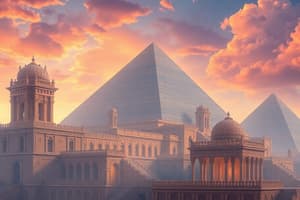Podcast
Questions and Answers
What was the main purpose of the pyramids in ancient Egypt?
What was the main purpose of the pyramids in ancient Egypt?
- To provide housing for the priests and religious leaders
- To serve as tombs for pharaohs and their consorts (correct)
- To act as astronomical observatories
- To store and protect important historical artifacts
Which of the following is NOT one of the three most famous pyramids in Egypt?
Which of the following is NOT one of the three most famous pyramids in Egypt?
- The Pyramid of Menkaure
- The Pyramid of Khafre
- The Pyramid of Hatshepsut (correct)
- The Pyramid of Khufu
What materials were used to build the pyramids?
What materials were used to build the pyramids?
- Sandstone and quartz
- Clay bricks and wood
- Marble and granite
- Large limestone blocks (correct)
What was the main purpose of the Egyptian temples?
What was the main purpose of the Egyptian temples?
What was the Temple of Karnak primarily dedicated to?
What was the Temple of Karnak primarily dedicated to?
Where is the most famous obelisk, Cleopatra's Needle, currently located?
Where is the most famous obelisk, Cleopatra's Needle, currently located?
What was the Rosetta Stone instrumental in deciphering?
What was the Rosetta Stone instrumental in deciphering?
What was the purpose of mortuary complexes in ancient Egypt?
What was the purpose of mortuary complexes in ancient Egypt?
What were obelisks typically made of?
What were obelisks typically made of?
What was the writing system used to write texts on temple walls, tombs, and other monuments in ancient Egypt known as?
What was the writing system used to write texts on temple walls, tombs, and other monuments in ancient Egypt known as?
Study Notes
Egyptian Architectures: A Journey Through Time
Egyptian architectures are a testament to the ancient civilization's engineering prowess, cultural richness, and religious beliefs. The remains of these architectural marvels continue to inspire and amaze visitors from all over the world. This article delves into the fascinating world of Egyptian architecture, exploring the majestic pyramids, impressive temples, mysterious obelisks, and intricate hieroglyphics that adorned their monuments.
Pyramids
Pyramids are perhaps the most iconic symbols of ancient Egypt. These monumental structures served as tombs for pharaohs and their consorts during the Old and Middle Kingdom periods. The three most famous pyramids are the Great Pyramid of Giza, the Pyramid of Khafre, and the Pyramid of Menkaure. These pyramids were built using large limestone blocks, weighing an average of 2.5-15 tons each.
The Great Pyramid of Giza, built for Pharaoh Khufu around 2580-2560 B.C., is the oldest and largest of the three pyramids. It is the only one of the Seven Wonders of the Ancient World still in existence. The pyramids are believed to have been built as a means of providing the pharaoh with a resting place in the afterlife.
Temples
Egyptian temples were grand, imposing structures, the most famous being the temples of the Theban Necropolis. These temples were built to honor the gods and were often used for religious ceremonies and rituals. They were typically constructed from sandstone and were decorated with intricate carvings and hieroglyphics.
The Temple of Karnak, dedicated to the god Amun, is the largest religious building in the world. It was built over a period of 1,300 years, with the last pharaoh to add to its immense size being Ramesses III. The temple's vastness and grandeur are a testament to the ancient Egyptians' devotion to their gods and their architectural prowess.
Obelisks
Obelisks, or tawosret, were long, tapering pillars with a pyramid-like shape at the top. They were often made of granite and were erected at the entrances of temples or in the center of cities. The most famous obelisk is the Cleopatra's Needle, now located in Central Park, New York. The obelisk was originally erected in the temple of Heliopolis, honoring the sun god Ra.
Hieroglyphics
Hieroglyphics were the written language of the ancient Egyptians, consisting of a combination of logographic and alphabetic symbols. They were used to write texts on temple walls, tombs, and other monuments. The writing system was adopted by the pharaohs and was considered the most sacred form of writing, reserved for religious texts.
The Rosetta Stone, a granodiorite stele inscribed in three scripts, was instrumental in deciphering hieroglyphics. The stone, discovered in 1799, has a decree issued at Memphis in 196 B.C., written in ancient Egyptian, the ancient Greek variant of the Egyptian language, and hieroglyphics. The Rosetta Stone allowed scholars to decipher hieroglyphics and gain a deeper understanding of ancient Egyptian culture.
Mortuary Complexes
Mortuary complexes, also known as necropoleis, were large cemeteries and complexes of tombs, including the pyramids of the pharaohs. These complexes were built to provide the deceased with everything they would need in the afterlife, including food, drink, clothing, and even furniture. The complexes were often decorated with hieroglyphics and were filled with treasures and offerings.
In conclusion, Egyptian architectures are a testament to the ancient civilization's engineering prowess, cultural richness, and religious beliefs. From the majestic pyramids to the impressive temples, mysterious obelisks, and intricate hieroglyphics, these architectural marvels continue to inspire and amaze visitors from all over the world.
Studying That Suits You
Use AI to generate personalized quizzes and flashcards to suit your learning preferences.
Description
Delve into the fascinating world of Egyptian architecture, exploring the majestic pyramids, impressive temples, mysterious obelisks, and intricate hieroglyphics that adorned their monuments. Learn about the iconic symbols of ancient Egypt, grand temples, long-tapering obelisks, and the sacred written language of the ancient Egyptians.




